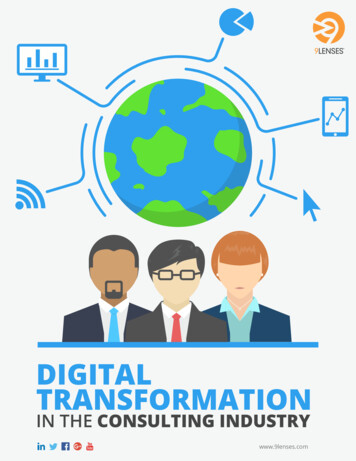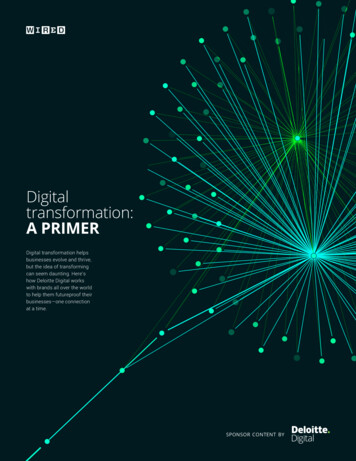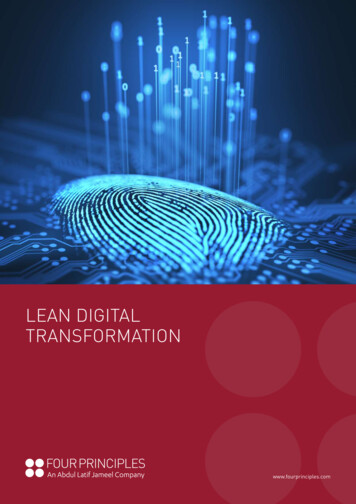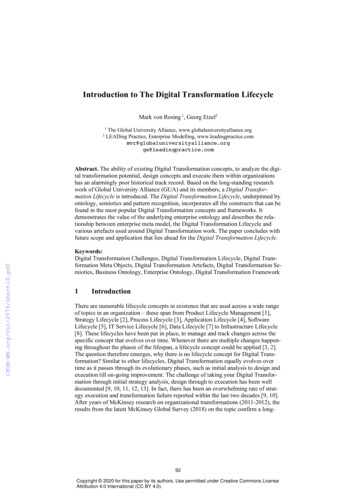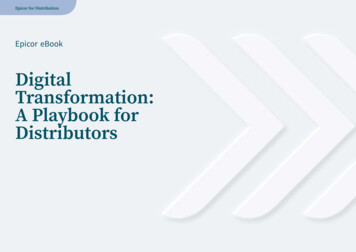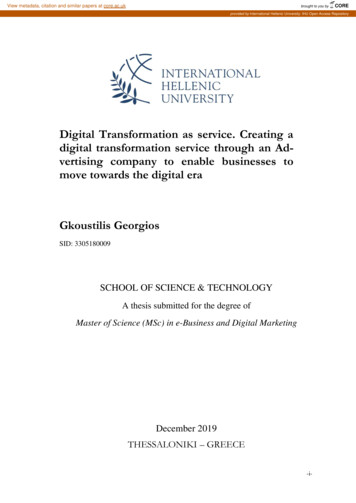
Transcription
View metadata, citation and similar papers at core.ac.ukbrought to you byCOREprovided by International Hellenic University: IHU Open Access RepositoryDigital Transformation as service. Creating adigital transformation service through an Advertising company to enable businesses tomove towards the digital eraGkoustilis GeorgiosSID: 3305180009SCHOOL OF SCIENCE & TECHNOLOGYA thesis submitted for the degree ofMaster of Science (MSc) in e-Business and Digital MarketingDecember 2019THESSALONIKI – GREECE-i-
Digital Transformation as service. Creating adigital transformation service through an Advertising company to enable businesses tomove towards the digital eraGkoustilis GeorgiosSID: 3305180009Supervisor:Prof. Ioannis MagnisalisSCHOOL OF SCIENCE & TECHNOLOGYA thesis submitted for the degree ofMaster of Science (MSc) in e-Business and Digital MarketingDecember 2019THESSALONIKI – GREECE-ii-
AbstractThis dissertation was written as part of the Master’s in e-Business and Digital Marketing at the International Hellenic University. The dissertation attempts to explore thepossibility of a Digital Agency offering digital transformation as a service. Companies,nowadays, struggle to keep up with the disruptive technological changes while at thesame time the need for digital transformation is rising faster than ever. The followingresearch was completed in collaboration with a Digital Agency in Greece. The findingof the paper concerns the efforts and activities of the company to provide clients a digital transformation service.I would like to express my gratitude to my Supervisor Professor Ioannis Magnisalis who wasalways willing to support and advise me, giving me the directions needed to complete this dissertation. I thank also, the members of the Digital Agency for the collaboration and help theyprovided.Georgios Gkoustilis02/11/2019-iii-
ContentsABSTRACT . III1 INTRODUCTION .11.1 OVERVIEW OF DIGITAL TRANSFORMATION .11.2 THE INFAMOUS CASE OF KODAK .11.3 OBJECTIVE OF THE DISSERTATION .21.4 STRUCTURE .32 DIGITAL TRANSFORMATION .42.1 WHAT IS DIGITAL TRANSFORMATION? .42.2 DIGITAL TRANSFORMATION CHALLENGES .52.3 STATISTICS AND INSIGHTS OF DIGITAL TRANSFORMATION STUDIES .62.4 THE FIRST STEP TO DIGITIZATION: MARKETING TRANSFORMATION .92.5 GOOGLE ANALYTICS AND DECISION MAKING.93 THE CASE OF THE DIGITAL AGENCY .113.1 THE DIGITAL ADVERTISING AGENCY .113.2 MASTER THESIS STUDENT RESPONSIBILITIES .113.3 SETTING UP THE ONLINE PRESENCE OF DIGIO .123.3.1 Competitor Analysis on e-Shop/website & Digital MarketingServices .123.3.2 Pricing of e-Shop/website & Digital Marketing Services .133.3.3 Competitors Analysis on e-Learning Platforms developmentservices .153.3.4 Competitor Analysis on Hosting Services for e-Shops .153.3.5 Pricing for hosting services .163.4 DIGIO SERVICES .173.5 DIGIO’S ONLINE PRESENCE .173.6 DIGIO’S CAMPAIGNS .193.6.1 Facebook target audience characteristics. .193.6.2 Second Facebook ad Campaign .213.7 CAMPAIGNS RESULTS .22-v-
3.8 GOOGLE ANALYTICS RESULTS . 234 DISCUSSION . 255 CONCLUSION . 276 BIBLIOGRAPHY . 28APPENDIX . 31-vi-
1 Introduction1.1 Overview of digital transformationIn recent years the rise of new technologies has brought many changes to industries thatwere looking to innovate and achieve a competitive advantage over their competitors.Digital technologies, like mobile, big data, social networks, predictive analytics andmore have enabled businesses to take initiatives in order to exploit and explore potentialbenefits. Furthermore, the increased demand from costumers and the increased competition due to globalization have pushed many companies to go digital either were ready ornot. Digital transformation enabled digital companies like Facebook or Amazon togrown bigger and stronger while traditional companies were facing a treat since theirtraditional value proposition was a state (J. Reis, 2018). Recent examples indicate thatmany companies were unable to go through a digital transformation successfully whichin some cases led to bankruptcy.Since the early stages of digital transformation, researchers tried to analyze and propose practices on how businesses should handle the digital transformation. Clayton M.Christensen and Michael E. Raynor with the book “The Innovator’s Solution” demonstrate a way where companies can create and sustain a successful growth. They believedthat a large number of innovations fail was because the responsibilities to build theseinnovating businesses, were given to organizations or managers whose capabilities weresimple, not adequate. While many believed that the main reason for innovations fail wasbecause the market wasn’t ready or because of a fatal technological flaw, Christensenand Raynor created a theory focusing on executives to help them create an organizational structure for their companies and select the right management team that both together will lead into building a successful business.1.2 The infamous case of KodakKodak was founded in 1880 by George Eastman while the first camera was developedin 1888. Kodak invested heavily in film since it was clear from the begging that con-1-
sumables were the key to success. The company grew bigger after the introduction ofcolor photography and by 1976, Kodak had captured the majority of the market. Kodakcontinued to grow and produce new products, increasing its sales year by year. In 1981new competitors started to rise while in 1986 the company introduced the firstmegapixel sensor. It was clear by then, that in order to survive, Kodak had to keep innovating since competitor was using new digital technologies to produce products. By1986 Kodak had invented over fifty products, capable of capturing or converting digitalimages but most of them failed because the cost of those products was too high for theconsumers. Kodak’s methods to cope with digital photography were inefficient and by1993, Kodak had gone through seven restructurings while in the same year the CEO ofthe company was replaced in order to achieve a more digital approach, creating the Digital and Applied department. Nonetheless, Kodak continued selling film and decided toinvest in the Chinese market, believing that it could be a great potential opportunity forthe company. By 1997, the sales of digital cameras had dramatically overcome the salesof film cameras and by that time many new companies, most of them were Japaneseelectronics firms, had been founded focusing on digital photography. In 2002 Kodakdecided to buy an online service company and in 2002 Kodak announced that a digitaltransformation strategy had been implemented while in the same year the companyclosed the film camera factory.1.3 Objective of the dissertationThe dissertation is trying to explore if a digital advertising agency can provide digitaltransformation as a service by building the online presence of the digital agency andpromoting the service mentioned above, to the public. This service offers training andeducation about the basic concepts of digital transformation. This way the service willenable, traditional companies to learn and implements those basic concepts to theirbusiness. The paper presents the setup of the online presence of the agency and the actions made to promote the service to specific audiences.-2-
1.4 StructureThe first chapter of the dissertation presents an overview of Digital transformation, thecase of Kodak and the objective of the dissertation. The second chapter highlights thedefinition of digital transformation, the way companies approach it and the first steptowards digital transformation. The third chapter presents the case of the Digital Agency, the actions, and efforts made to create an online presence, and market analysis. Also,the chapter presents the results of the actions mentioned above. Finally, chapters fourand five present the discussion and conclusions of the dissertation.-3-
2Digital Transformation2.1 What is digital transformation?Digital transformation holds numerous definitions that created over the years. Experts,scientists, and authors who examined digital transformation from various angles definedit differently while keeping at the same time a common ground on their definitions. Digital transformation can be described as the use of digital technologies (analytics, socialmedia, mobile) to rapidly improve a business. (Liere-Netheler et al.2018) or as a blueprint that helps companies to integrate new technologies into their business and improvethe company’s operations. (Matt et al.2015). Moreover, digital transformation is described as a digital force that enables businesses to improve their operations while at thesame time leads companies to create new business models (Haffke et al.2016).Another definition describes digital transformation as “the changes and transformations that are built on a foundation of digital technologies” (Nwankpa and Roumani.2016). Those transformations and changes may involve social media platforms, bigdata, cloud computing, mobile phones or analytics. Businesses are constantly trying totransform and evolve their business by using the digital technologies mentioned aboveto enhance their operations and processes and to achieve fundamental changes and improvements in value creation.Clohessy defines digital transformation as the changes it brings to businesses' models.Those changes lead businesses to reshape the organizational structure of the company,the operations, and processes. (Clohessy et al.2017)Digital transformation can be seen by many as the impact of IT on a company whichmeans that it is the alignment of business and IT. (Li et al. 2017). In specific, digitaltransformation has a disruptive impact on the organizational structure of a company, theinformation flow, and routines.Also, digital transformation is depicted as “an evolutionary process” (Morakanyane etal. 2017). This process will enable new digital capabilities for business, reshape thebusiness models and the operational processes while at the same time will create valueand enhance the customer experience.-4-
Finally, according to Andriole, digital transformation is not just a supply chain improvement project or a software upgrade but a disruptive shock to a functioning system(Andriole. 2017)2.2 Digital transformation ChallengesNowadays, digital transformation is considered a social phenomenon and for businesses, a cultural evolution. This evolution brings numerous challenges that businesses musttackle in order to survive. This means that companies in many cases must adapt by either creating a new business model or changing the one that already have. Digital transformation can affect various parts of a company such as the organizational structure, theculture, the ethics, and the workplace.Businesses, nowadays, are struggling to address customer needs. Those needs are constantly becoming more and more demanding. Companies that have the capabilities andknowledge to address those needs have a competitive advantage over companies whohave to reshape their business models or products according to consumer trends. Usually, the first step towards a digital transformation that companies do, is by transforming areshaping the marketing department. This transformation is highly connected with internet and social network technologies and it’s the best solution for companies to address or identify the customer needs. By transforming the marketing department, companies usually proceed by implementing CRM (Customer Relationship Management)systems to better analyze their customers. (Emily Henriette. 2016)However, digital transformation can bring internal challenges in a company, meaningthe collaborations between employees. A digital transformation implies the use of newtechnologies by the employees of the company, which in many cases, employees mighthave difficulties adapting to those new technologies since the have to change the waythey use to work. Some of the new technologies can be collaborative technologies thatreshape a company’s workplace or remote working technologies. Collaborative platforms offer many benefits to a company, but it might be harmful if employees find itdifficult to adapt fast and efficiently. One of the first examples of internal digitization isthe implementation of ERP (Employee Relationship Management) systems that utterlytransformed the human resources department of businesses. (Emily Henriette. 2016)-5-
The digitization of companies created new labor needs and companies find themselvesin a difficult position, covering those needs. New technologies require certain expertisefrom employees which in many cases is hard to find.2.3 Statistics and Insights of digital transformation studiesDigital transformation is creating an increasing amount of challenges that businessesmust face. In March of 2019, a survey held on in the UK asking retailers about the digital transformation challenges. The retailers were focusing on the sector of general merchandise, electricals, health and beauty, fashion, entertainment, department stores,sports, and leisure. The majority answered that the lack of digital skills internally is thebiggest challenge they must face. While the second is the lack of cultural adoption ofthe digital transformation strategy, followed by the unawareness of training prioritization.Image 2: Retailers who agree that the need for digital transformation increased in the last three years, by countryIn 2017 a worldwide survey conducted focusing on the digital transformation status inorganizations. The survey was asking the participants to answer, “Which of the following best describes the status of your organization's digital transformation strategy?".-6-
Image 3: Digital transformation status in organizations worldwide as of 2017From the 907 respondents, the majority is actively digitalizing the business processes.While 30% of the respondents are planning a digital transformation, there is a 9% thathas no digital transformation strategy.Besides digital transformation strategies, companies also have key objectives in theirdigital business strategy that wish to achieve. According to the responses of a worldwide survey conducted in 2019, most companies identify the customer experience as thekey objective of their digital transformation. There are also, a considerable amount ofcompanies focusing on process automation while some companies believe that the keyobjective of their digital transformation is to drive new revenue.Image 4: Key objectives of digital business strategy in organizations worldwide as of 2019-7-
Image 4: Key objectives of digital business strategy in organizations worldwide as of 2019By observing the image above (image 4), it is clear that there is no dominant key objective of digital business strategy and all answers are relatively close in presentence.Another interesting statistic to better understand the importance of digital transformation in business is a survey carried out in Europe in 2019. The survey is trying toidentify the top digital in-store technologies, retailers are using.Image 5: Share of digital in-store technologies retailers are using in Europe in 2019-8-
2.4 The first step to digitization: Marketing transformationAs mentioned above, companies who want to transform their business usually start bytransforming the marketing department first. This transformation slowly created digitalmarketing. Digital marketing, as it is described by the Financial Times, is the use ofdigital technologies on the Internet in order to promote products and services to users.The reason that digital marketing is often approached first by companies, is because ituses digital technologies on the Internet, like apps or social media, which are also usedby the consumers or the employees of the company, making it this way, easier to implement. Digital marketing is using systems based on the internet and through digitalnetworks is trying to create, transit and accelerate product value to the consumer (Heikki, 2015). Some of the methods of digital marketing are: Search Engine Optimization (SEO) Content Marketing Influencer Marketing Content Automation Campaign Marketing Data-driven Marketing E-commerce marketing Social Media Marketing Social Media optimization E-mail direct marketing Display Advertising2.5Google Analytics and Decision MakingGoogle Analytics is a web analytics tool that enables users to track their website trafficswith reports. Google Analytics is usually integrated with Google ads so users can have abetter understanding of their online campaigns by tracking conversions(goals) and landing pages on their website. Google Analytics offers dashboard-type data to the user sobetter analyze and understand the performance of their website (Google Develop-9-
ers.2017). Some of the characteristics of Google Analytics are the referrers that monitorwhere visitors came from, sessions, the average time spent on the website or on a specific page, bounce rate, which monitors how fast a user left the website after entering.Also, it can capture the devices, users used to access the website or the keywords that auser typed on google search to find the website. Furthermore, user can track sales activities through e-commerce reporting, or their revenue, site’s transactions and other metrics (Cerebro Marketing 2016) Also, google analytics can track the demographics ofvisitors, which means that companies can get insights about the visitors’ age, gender orlocation to better optimize their advertisements. Finally, google analytics is using pagetags, better known as google analytics tracking code. This code is a snippet of JavaScript and it is embedded to every page of a website.Finally, google analytics offers insights that can enhance a company’s performance.Demographics can help a company to adjust the campaign according to target audiences, website and page monitoring can enable the company to improve its website and thevisitor experience while e-commerce reporting can lower the costs by better allocatingthe budgets (Google Developers.2017). Overall, the use of google analytics or analytics,in general, can improve the decision making of a company.-10-
3 The case of the DigitalAgency3.1 The digital advertising agencyThe digital adverting agency named Digio was operating in Greece for years without anonline presence, offering on e-shop and website development, e-learning platforms development, and Facebook/google ads. The fact that Digio was operating without a digital presence gave to this dissertation, the opportunity to create an online presence for thecompany and create a digital transformation service in order to promote it and attractnew clients. The purpose of the service is to attract traditional Greek companies that aretrying to evolve their business, learn more about the digital era and keep up with thetechnological changes.3.2 Master Thesis Student ResponsibilitiesThe Master Thesis student had to work closely with the company member and attendseveral meetings in order to create the online presence of the company. The key responsibilities and tasks were: Website development Social media management Market Research Content creation Blogging Google Analytics monitoring Google Ads creation Facebook ads creation-11-
3.3 Setting up the online presence of DigioBefore starting to set up the online presence of Digio a competitor analysis was madefocusing on e-shop/website services, digital marketing services, e-learning developmentservices and hosting services for e-shops and websites.3.3.1Competitor Analysis on e-Shop/website & Digital MarketingServicesTo find the best companies providing website development we used google search. Wethought that companies who know how to promote their business through the web andappear in the top results of google searches are possible to provide the best services too.The keywords used for the companies below are “Website development in Thessaloniki” “Website Thessaloniki” meaning that the companies mentioned below are based andoperating in SocialGraphicMrkMediaD. &Video( ads)1Digital 11BNS -12-
Smartmoves20TrueTrueTrueTrueTrueTrueTrueTable 1: Competitor Analysis on e-Shop/website & Digital Marketing ServicesOther Services Training Consulting Brand Marketing Website for people with disabilities WCAG 2.0 AA E-Mail Marketing ERP Web Radio Technical support Affiliate Marketing Seminar (for Digital Marketing) GDPRFigure 1: Competitor Analysis e-shop/website & Digital Marketing ServicesAccording to Table 1, the digital agencies mentioned above are covering a vast varietyof services. Two small gaps are visible. The first is the app's development and the second one is the graphic design and video.3.3.2Pricing of e-Shop/website & Digital Marketing ServicesFrom the twenty companies that were analyzed only three had visible pricing of packages on their website while for the rest, you had to get in touch with the company in or--13-
der to get an offer and learn more about the prices. The three companies are MONDO,infocus and owlTech as mentioned below.Figure 2: MONDO company pricing packagesFigure 3: infocus company pricing packages-14-
Figure 4: owltech company pricing packages3.3.3Competitors Analysis on e-Learning Platforms developmentservicesSince Digio was experienced in developing e-learning platforms, a competitor analysiswas made, focusing on companies that offer e-learning platform development services.The keyword used to identify competitors in e-learning platform is “e-learning platformdevelopment in Thessaloniki or TrueFalseFalseFalseFalseFalseFalse3WIDE .4Competitor Analysis on Hosting Services for e-ShopsFinally, a competitor analysis was made, focusing on hosting services for e-shops.Comp. Name1papakiOption1/ Option2/ Option3/ OptionPricingPricingPricingPricing20.83 65.83 190.83 4/-15-
2Top.host5.83 9.83 16.58 3IpHost2.56 4.40 6.80 4multihosting01.00 2.95 7.95 5pointer1.90 2.90 5.90 9.90 6dnhost3.65 7.75 13.15 7hostsun01.90 3.50 8intechs2.77 5.55 8.33 9thewebpower1.33 3.00 5.17 10sigmaweb1.90 4.30 9.40 19.95 7.90 6.37 Table 3: Competitor Analysis on Hosting Services for e-Shops3.3.5Pricing for hosting servicesThe only company worth mentioning is Papaki.gr, which is one of the most well-knowncompanies in the field of website hosting in Greece. Apart from web-hosting, Papakihas a vast variety of other services: Semi Dedicated Hosting Email Hosting Domain registration Domain transfer Corporate Services (Domain Management) SSL servicesFigure 5: Papaki.gr, pricing and services-16-
3.4 Digio servicesAfter analyzing the competitor analysis, the members of the company decided to proceed with the services mentioned below. Website development E-shop development Market research Social media management Digital marketing (Google ads, Facebook ads, e-mail marketing) ROI Analysis TrainingApart from the services mentioned above, Digio decided to offer a combination of services called “We make you Digital”. By using the service companies could train theirstaff on how to manage and administrate a website/e-shop or an account on social media. Also, they could learn metrics from google analytics and online ads to get more insights and improve their decision making. Overall, the service was offering a first stepto digital transformation, especially for traditional companies, helping them to keep upwith new technologies and slowly evolve their business.After discussion and several meetings with the members of the company, they decidedto exclude e-learning platforms development and hosting services to focus their effortson marketing-oriented services so they can have better results.3.5 Digio’s online presenceDigio’s first step towards an online presence was to develop a website. The website developed using WordPress. Also, Google Analytics was connected to the website to better monitor the daily web-traffic of the website. Through the website, visitors couldlearn about the services, the company, read news published on the blog or contact withthe company. Moreover, a matrix of services was implemented so visitors could chooseexactly the services they want and learn about the prices at the same time. Digio believed that visitors should know exactly about the pricing of the services and it is a wayto attract more clients.-17-
This matrix of services would promote the transparent and honest character of Digio tothe public. Since only a few competitors’ websites had a visible price on their websites,by using the matrix of services, Digio could achieve a competitive advantage over itscompetitors. Next to the matrix of services, visitors could fill a form, asking their question or describing the project they wish Digio to take on. Furthermore, visitors could askfor a free assessment of their online presence (if they had one), ask for suggestions andadvice on how to improve their online presence and suggestions and advice on what todo next.Figure 6: Digio website, matrix of servicesBesides, social media accounts of Digio was created to better target audiences. The accounts were created in Facebook and LinkedIn and the content was focusing on digitalmarketing and e-shop development.-18-
3.6 Digio’s CampaignsTo promote its services, Digio launched three campaigns using ads. Two of them wasFacebook ads using Facebook’s Ad Manager while one was Google ads. The target audience was men and woman, between 25-65 years old who had their own business andwere operating in Greece.The first campaign on Facebook washeld on from the 28th of August until the11th of September 2019. The objective ofthe campaign was to increase awarenessand the web traffic of the website whilethe content of the ad was about theDigio’s services that were mentionedabove. In specific the ads had threeunique parts aiming attract different visi-Figure 6: First Facebook Campaigntors depending on their need. The first part was focusing on Digital Marketing Strategies, the second on e-shop and website online advertising and promotion and the third,on data analysis and dashboards.3.6.1Facebook target audience characteristics.As mentioned above, the company wanted to target business owners operating inGreece. The keyword used to better describe this audience was focusing on interests,behaviors and job titles.Interests: Web analytics Content marketing Email marketing AdWords Keyword research Web traffic, AdSense Landing page-19-
Marketing strategy Entrepreneurship Social media marketing Promotion (marketing) Display advertising Online advertising Advertising Advertising campaign Advertising agency or Google AnalyticsBehaviors: Small business
consumers. Kodak's methods to cope with digital photography were inefficient and by 1993, Kodak had gone through seven restructurings while in the same year the CEO of the company was replaced in order to achieve a more digital approach, creating the Dig-ital and Applied department. Nonetheless, Kodak continued selling film and decided to




